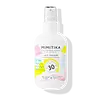What's inside
What's inside
 Key Ingredients
Key Ingredients

 Benefits
Benefits

 Concerns
Concerns

 Ingredients Side-by-side
Ingredients Side-by-side

Water
Skin ConditioningDibutyl Adipate
EmollientPhenylbenzimidazole Sulfonic Acid
UV AbsorberEthylhexyl Salicylate
UV AbsorberPolyglyceryl-6 Stearate
EmollientDimethicone
EmollientPropanediol
SolventSilica
AbrasiveTromethamine
BufferingDiethylamino Hydroxybenzoyl Hexyl Benzoate
UV FilterBis-Ethylhexyloxyphenol Methoxyphenyl Triazine
Skin ConditioningGlycerin
HumectantParfum
MaskingPentylene Glycol
Skin ConditioningCetearyl Alcohol
EmollientGlyceryl Stearate
EmollientTrimethylpentanediol/Adipic Acid/Glycerin Crosspolymer
Skin Conditioning1,2-Hexanediol
Skin ConditioningXanthan Gum
EmulsifyingCaprylyl Glycol
EmollientPolyglyceryl-6 Behenate
Emulsion StabilisingTocopherol
AntioxidantHydrolyzed Algin
Sodium Phytate
Magnesium Sulfate
Manganese Sulfate
Skin ConditioningHelianthus Annuus Seed Oil
EmollientMusa Sapientum Fruit Extract
Skin ConditioningCI 15985
Cosmetic ColorantWater, Dibutyl Adipate, Phenylbenzimidazole Sulfonic Acid, Ethylhexyl Salicylate, Polyglyceryl-6 Stearate, Dimethicone, Propanediol, Silica, Tromethamine, Diethylamino Hydroxybenzoyl Hexyl Benzoate, Bis-Ethylhexyloxyphenol Methoxyphenyl Triazine, Glycerin, Parfum, Pentylene Glycol, Cetearyl Alcohol, Glyceryl Stearate, Trimethylpentanediol/Adipic Acid/Glycerin Crosspolymer, 1,2-Hexanediol, Xanthan Gum, Caprylyl Glycol, Polyglyceryl-6 Behenate, Tocopherol, Hydrolyzed Algin, Sodium Phytate, Magnesium Sulfate, Manganese Sulfate, Helianthus Annuus Seed Oil, Musa Sapientum Fruit Extract, CI 15985
Octocrylene
UV AbsorberC12-15 Alkyl Benzoate
AntimicrobialEthylhexyl Salicylate
UV AbsorberButyl Methoxydibenzoylmethane
UV AbsorberBis-Ethylhexyloxyphenol Methoxyphenyl Triazine
Skin ConditioningHexylene Glycol
EmulsifyingIsopropyl Isostearate
EmollientTriacontanyl Pvp
HumectantGlyceryl Stearate
EmollientPEG-100 Stearate
Caprylyl Glycol
EmollientTribehenin
EmollientAluminum Starch Octenylsuccinate
AbsorbentPotassium Cetyl Phosphate
EmulsifyingAcrylates Copolymer
Disodium EDTA
Sodium Hydroxide
BufferingPentaerythrityl Tetra-Di-T-Butyl Hydroxyhydrocinnamate
AntioxidantTocopheryl Acetate
AntioxidantPhenoxyethanol
PreservativePotassium Sorbate
PreservativeParfum
MaskingOctocrylene, C12-15 Alkyl Benzoate, Ethylhexyl Salicylate, Butyl Methoxydibenzoylmethane, Bis-Ethylhexyloxyphenol Methoxyphenyl Triazine, Hexylene Glycol, Isopropyl Isostearate, Triacontanyl Pvp, Glyceryl Stearate, PEG-100 Stearate, Caprylyl Glycol, Tribehenin, Aluminum Starch Octenylsuccinate, Potassium Cetyl Phosphate, Acrylates Copolymer, Disodium EDTA, Sodium Hydroxide, Pentaerythrityl Tetra-Di-T-Butyl Hydroxyhydrocinnamate, Tocopheryl Acetate, Phenoxyethanol, Potassium Sorbate, Parfum
Ingredients Explained
These ingredients are found in both products.
Ingredients higher up in an ingredient list are typically present in a larger amount.
You might know this ingredient as Tinosorb S or Bemotrizinol. It is a UV filter that covers both UVA and UVB rays.
This ingredient has two peak UV absorption peaks ( 310 and 340 nm) and is able to absorb both UV-A and UV-B rays. This ingredient works by preventing UV rays from reaching and damaging your skin.
On top of that - it is highly photostable and helps prevent the photodegration of other sunscreen ingredients such as avobenzone.
Tinosorb S is allowed in the EU, Australia, and Asia. It is close to being approved by the FDA and we'll hopefully get this ingredient in the U.S. by late 2025.
Fun fact: Tinosorb S is the most effective UV absorber at maximum concentration (measured by SPF) permitted in the EU.
This ingredient is oil-soluble, so your oil-cleansers will take this right off at night.
Learn more about Bis-Ethylhexyloxyphenol Methoxyphenyl TriazineCaprylyl Glycol is a humectant and emollient, meaning it attracts and preserves moisture.
It is a common ingredient in many products, especially those designed to hydrate skin. The primary benefits are retaining moisture, skin softening, and promoting a healthy skin barrier.
Though Caprylyl Glycol is an alcohol derived from fatty acids, it is not the kind that can dry out skin.
This ingredient is also used as a preservative to extend the life of products. It has slight antimicrobial properties.
Learn more about Caprylyl GlycolEthylhexyl Salicylate is an organic compound used to block UV rays. It primarily absorbs UVB rays but offers a small amount of UVA protection as well.
Commonly found in sunscreens, Ethylhexyl Salicylate is created from salicylic acid and 2-ethylhexanol. You might know salicylic acid as the effective acne fighter ingredient and BHA.
The ethylhexanol in this ingredient is a fatty alcohol and helps hydrate your skin, similar to oils. It is an emollient, which means it traps moisture into the skin.
According to manufacturers, Ethylhexyl Salicylate absorbs UV wavelength of 295-315 nm, with a peak absorption at 307-310 nm. UVA rays are linked to long term skin damage, such as hyperpigmentation. UVB rays emit more energy and are capable of damaging our DNA. UVB rays cause sunburn.
Learn more about Ethylhexyl SalicylateGlyceryl Stearate is a mix of glycerin and stearic acid.
It is used to stabilize the mixing of water and oil ingredients. By preventing these ingredients from separating, it can help elongate shelf life. It can also help thicken the product's texture.
As an emollient, it helps soften skin and supports barrier-replenishing ingredients.
In cosmetics, Glyceryl Stearate is often made from vegetable oils or synthetically produced.
This ingredient may not be fungal-acne safe
Fun fact: The human body also creates Glyceryl Stearate naturally.
Learn more about Glyceryl StearateParfum is a catch-all term for an ingredient or more that is used to give a scent to products.
Also called "fragrance", this ingredient can be a blend of hundreds of chemicals or plant oils. This means every product with "fragrance" or "parfum" in the ingredients list is a different mixture.
For instance, Habanolide is a proprietary trade name for a specific aroma chemical. When used as a fragrance ingredient in cosmetics, most aroma chemicals fall under the broad labeling category of “FRAGRANCE” or “PARFUM” according to EU and US regulations.
The term 'parfum' or 'fragrance' is not regulated in many countries. In many cases, it is up to the brand to define this term.
For instance, many brands choose to label themselves as "fragrance-free" because they are not using synthetic fragrances. However, their products may still contain ingredients such as essential oils that are considered a fragrance by INCI standards.
One example is Calendula flower extract. Calendula is an essential oil that still imparts a scent or 'fragrance'.
Depending on the blend, the ingredients in the mixture can cause allergies and sensitivities on the skin. Some ingredients that are known EU allergens include linalool and citronellol.
Parfum can also be used to mask or cover an unpleasant scent.
The bottom line is: not all fragrances/parfum/ingredients are created equally. If you are worried about fragrances, we recommend taking a closer look at an ingredient. And of course, we always recommend speaking with a professional.
Learn more about Parfum